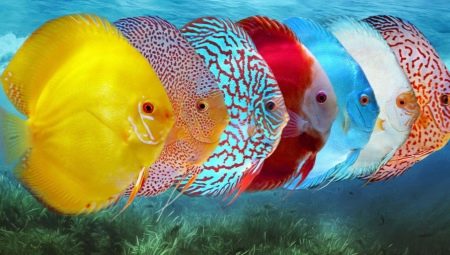The true king of any aquarium - the discus - belongs to the cichlid family and has characteristic sizes and climatic preferences. Among the representatives of this species of fish, you can find both individuals that have retained their original color and appearance, as well as unusual hybrids obtained by artificial means. However, any discus has such a bright charisma that it simply cannot be ignored. And the rather complicated maintenance of the fish in the aquarium and the care for them are fully compensated by the pride of owning such an unusual pet.
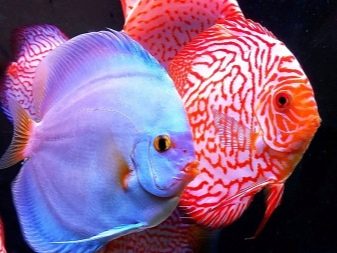
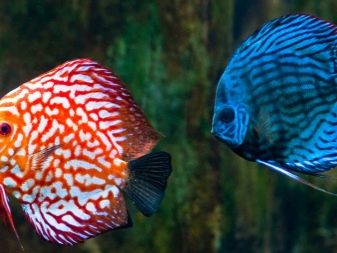
Features
Discus aquarium fish is an exotic guest arriving in the countries of Europe and Asia from South America. The natural habitat for it is fresh water of local rivers with a weak current and a rather high temperature. Discus live in the Amazon and its tributaries, while they have a very characteristic appearance. True, they did not inherit the proprietary pugnacity of their counterparts - the fish are distinguished by their peace-loving character, but their size greatly limits the possibilities for neighborhood with other aquarium inhabitants.
Discus inherited its bright color from nature, and a large number of hybrids was only a continuation of selection. Yellow and orange, red, brown, silver-white, blue, green - these fish have an incredibly attractive appearance. The body flattened in most breeds has a disc-shaped shape. The head of representatives of this species is small in size in comparison with the body, a small mouth.The eyes of almost all forms of discus have a reddish tint, fins well developed, long.
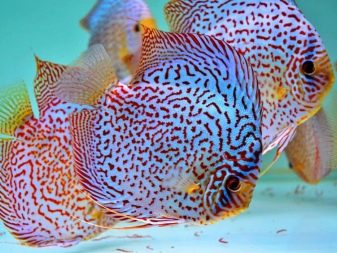
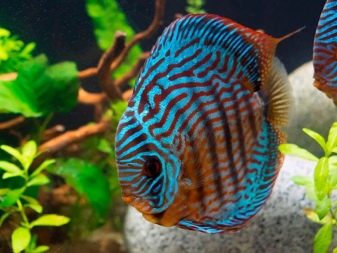
Many features of the discus are associated with their original habitat. Water in the tropical rivers of Amazonia has a very soft composition, there are almost no active microorganisms. Accordingly, the immune system of fish initially does not have this necessary protection. In addition, in small tributaries, the current is weak or almost unexpressed; discuses prefer to live in thickets off the coast.
Aquarium varieties of discus grow up to 20 cm in length, have a bright, varied color, almost all breeds have three longitudinal blue stripes, the transverse stripes of hybrids are often replaced by spots.
Females are always paler than males.
Discus fish belong to perch-like ray-finned fish, do not differ in aggressive character, can be considered long-livers - they can be a decade in the aquarium if kept in an aquarium. The unusual appearance and variety of colors brought the discus a well-deserved popularity. These tropical guests are considered real kings among their fellows.Today they are bred everywhere in Europe, in Southeast Asia. In nature, fish prefer to live in flocks of 8-10 individuals, it would be better if they get similar conditions in an artificial reservoir.
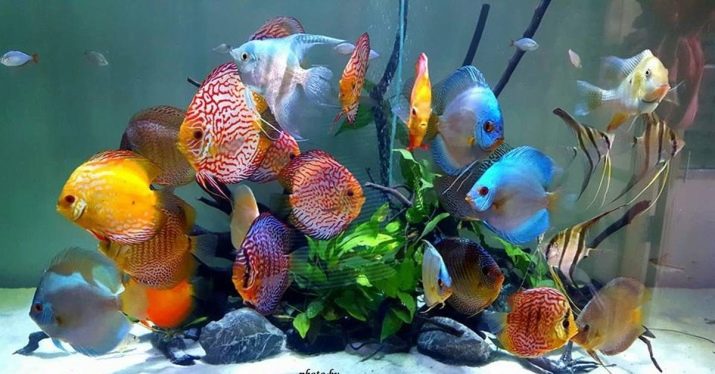
Varieties
Among all the subspecies of the discus, one can distinguish the basic types found in nature, and hybrids obtained as a result of their crossing. Thus, all diversity is built on the genes of three ancestors who gave their source material for the benefit of posterity.
We list the basic types.
Haeckel Discus
The fish has a background color in beige and pink colors. Stripes of a turquoise hue horizontally pass over it, and contrasting dark lines adorn the body in a vertical plane. An eye of black-brown color on their background is almost invisible. The breed was described in 1840, the very first of the discus, lives in Brazil.
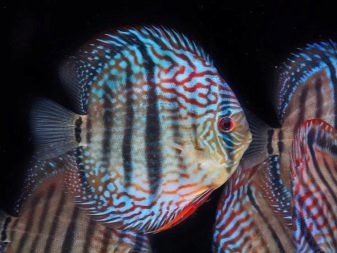
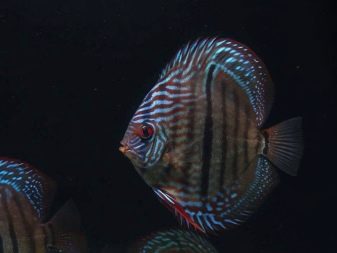
Green discus
This species has a greenish-brown body color, with 9 dark transverse stripes. Despite the name, the variation of colors here allows a lot of nuances - from red to yellow. The fish is characterized by the presence of feather-shaped, high fins, the iris of the eye is painted in red-brown tones. Discus was described in 1904, its natural habitat is the rivers of Brazil and Peru.
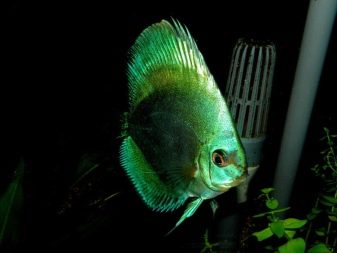
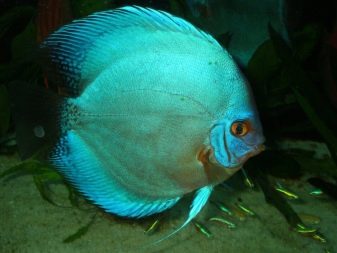
Brown discus
A fish with a yellow or brown body, the head and fins have thin neon-blue stripes, the body does not always have vertical contrasting stripes, but normally they should be present. The eyes have an unusual red color.
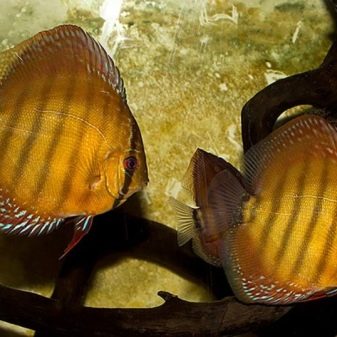
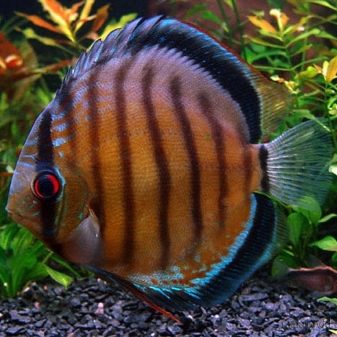
Blue discus
Known since 1960. It is found in the Amazon, in the lower parts of its course.
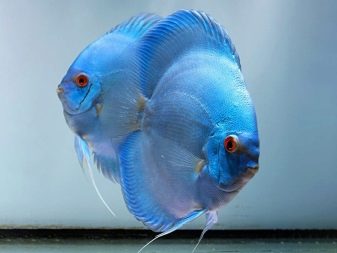
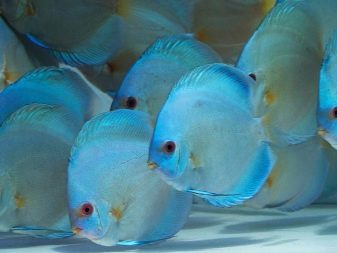
Popular hybrids include many varieties.
There are so many hybrid options for discus that not every amateur aquarist can recognize them all. It is important to understand that buying a hybrid is always a bit of a “lottery”. Bred artificially fish are much more demanding of the conditions of detention, vulnerable to pathogens. In addition, fixing the color of the offspring during breeding is extremely rare. A guarantee can only be obtained by purchasing an elite pet with a certificate (an analogue of the pedigree), such discuses are obtained by crossing breeding and wild species.
Ocean green
Hybrid Diskus, with an expressive greenish-blue color. The body has a yellowish tint, no stripes. Red eyes give out belonging to albinos.
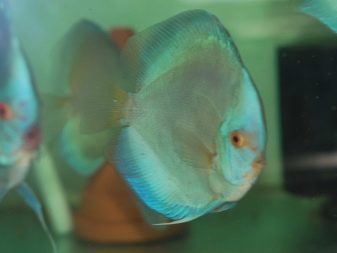

Pigeon blood
Pigeon blood is a hybrid obtained in Thailand by crossing a striped-turquoise variety with red turkis. As a result of selection, a view was obtained with white scales covered with wavy red stripes located longitudinally. The eyes also have a red color, there are similar stripes on the fins.In general, the fish looks rather unusual, but retains the main breed characteristics.
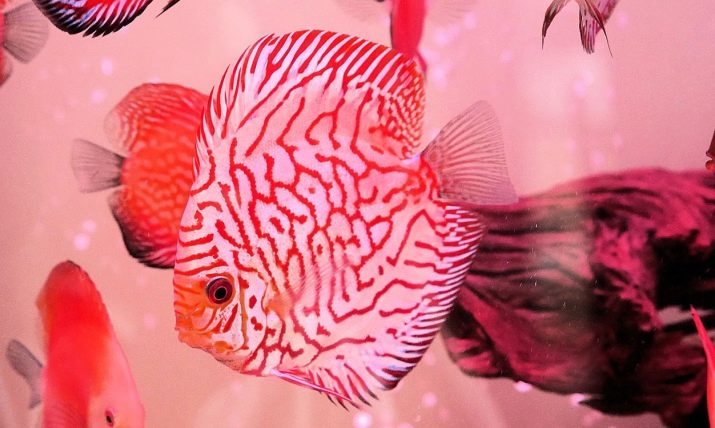
Marlboro
One of the subspecies of Pigeon Blood. The fish has a brightly colored body in orange-red tones, the predominance of one or another shade is permissible. Bthe yellow spots characteristic of the parent breed remained only on the abdomen and dorsal, closer to the head. The fins are also covered with colorful ripples. The body shape of the marlboro is more round than that of the other discus, it is interesting to observe them in the aquarium, and even just one fish, due to its size, does not go unnoticed.
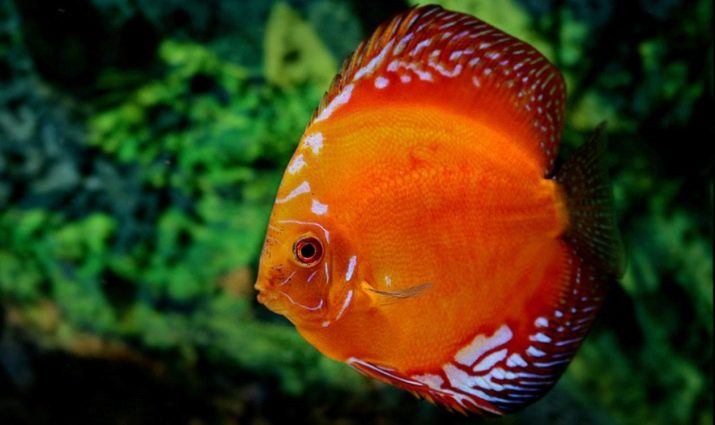
Ghost
A popular variety among amateurs, which came from Malaysia to Europe back in 1980. Fish with a "transparent" body were obtained by closely related crossing of diamond Turks. Among the features of "ghosts" we can distinguish a weak sexual constitution in males - no more than 10% are able to produce offspring.

Golden
A selection hybrid from Malaysia, a natural form does not exist. The brown discus was taken as a basis, by closely related and reverse crossing, which allowed to highlight a line with a saturated yellow color of color without stripes and spots.
Modern Golden discus mating with turquoise Snake Skin, the offspring produces about 70% of fish with a clean background tone of a rich golden hue.
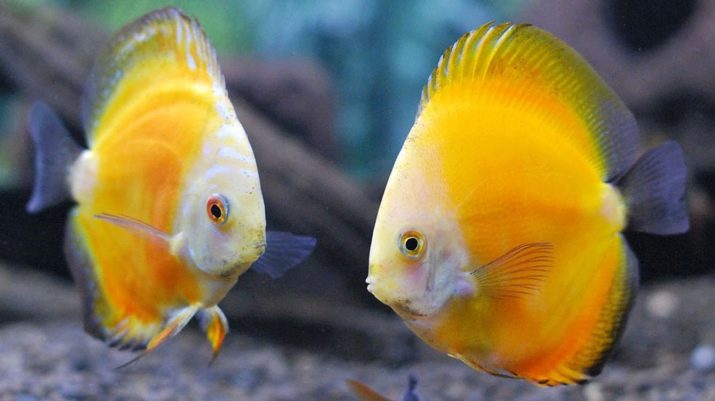
San mera
Hybrid, in 90% of cases inheriting parental traits. The fish was bred in Singapore as a result of many years of selection, securing the bright blue stripes located horizontally, above and below the body. The general background is bright red, the eyes match the color.
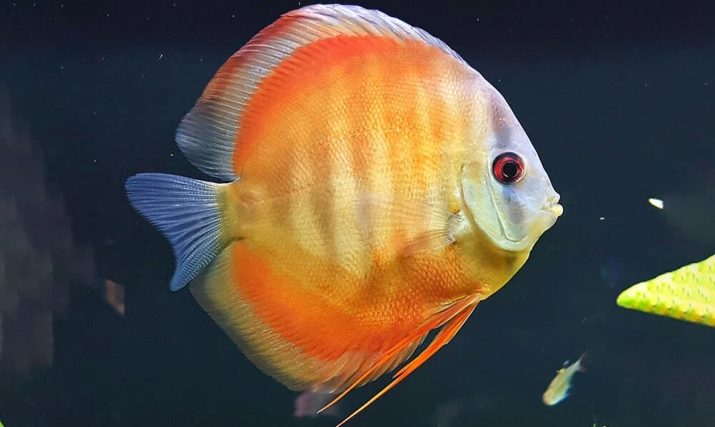
Leopard
A hybrid variety that appeared due to the crossing of red turkis and green discus. The fish belongs to albinos, has red eyes and white background scales, covered with scarlet spots. Actually, for the drawing on the body, she got her nickname. Leopard discus is very sensitive to light. They grow large - an adult can reach 20 cm in length.
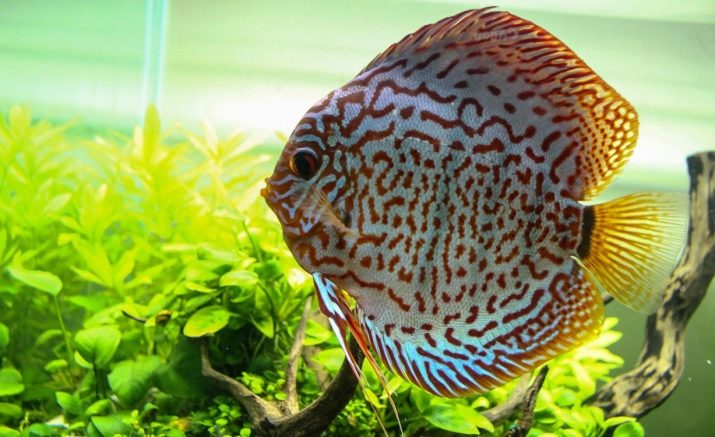
Snake skin
A hybrid variety that gave rise to many other types of color. It is characterized by a complex mesh pattern on a white background, red eyes. Among the color variations, one can distinguish Tiger Snakeskin with tiger stripes, Fine Line Snakeskin with sophisticated lines, a more pronounced pattern.
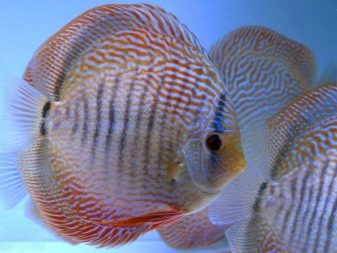
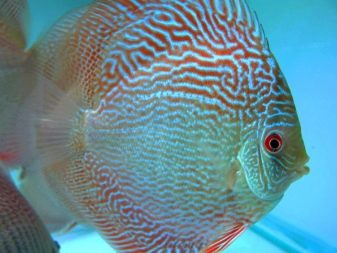
Cobalt
A beautiful view of discus featuring turquoise. Characteristic vertical stripes are present on the body, but become less noticeable with age. Scales have a lot of brilliant impregnations, giving its owner an elegant look. The hybrid is rather highly regarded among amateurs.
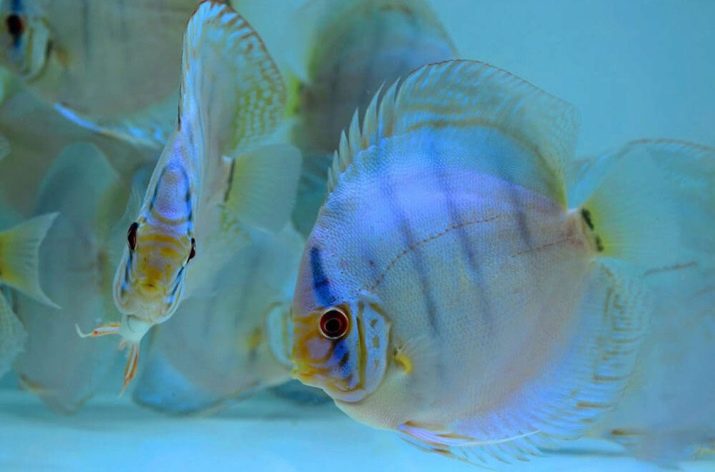
Blue diamond
Discus of this breed is found in the natural environment, but have a paler color. Aquarium varieties have a more saturated color. Body color is usually monochromatic - from blue to pale non-forget-me-not; a metallic glow with a greenish tint appears in fashion. The eyes of the fish are red, the stripes on the body are absent, the body is round and tall, flat.

Snow white
The hybrid was obtained more than 20 years ago by breeders from Malaysia. The progenitor of a snow-white discus was his brown brother. Albino has characteristic red eyes, a very bright body with a neon glow, looks incredibly impressive. In this hybrid, the presence of a yellowish head, yellow and pink shades on the body is permissible, fins can cast blue and blue.
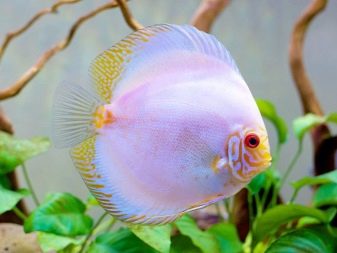
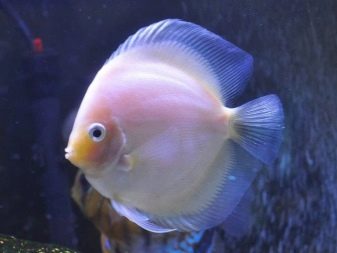
Red
Most often found in the wild as Hekkel's discus. When breeding in captivity, it can be called pompadour. On the body there are longitudinal lines of a blue hue, dark vertical stripes. The color is inconsistent - with strong excitement, the banding is replaced by a solid brown background.
Under severe stress, the red discus becomes gray-pink.
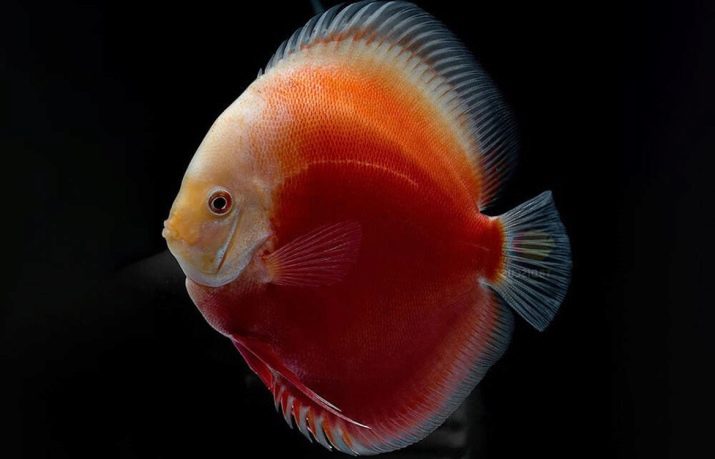
Compatibility
Experienced aquarists recommend keeping the discus exclusively in species - monobreed aquariums.This restriction is associated with weak immunity, even those dangers that are not harmful to their stronger brothers are fatal for fish. It is important to take into account the rather high temperature of the water - only armored catfish, at the same time ready to play the role of orderlies, cleaners of the territory, can feel comfortable in it. Otherwise, compatibility with other aquarium fish is pretty good - the discus itself does not show aggression, are considered peace-loving pets.
Among the species that can be kept in a common reservoir with these large fish, one can name red-headed tetra, blue Congo. Discus and shrimp get along with each other, you can run apple snails into the aquarium. Between themselves different breeds of this species also do not argue, you can safely choose pets with different body colors. Neons, ancistruses are well suited for the neighborhood.
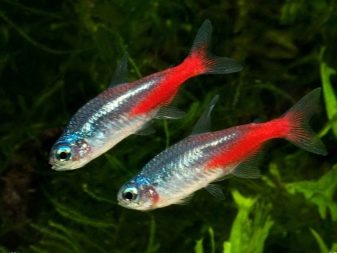
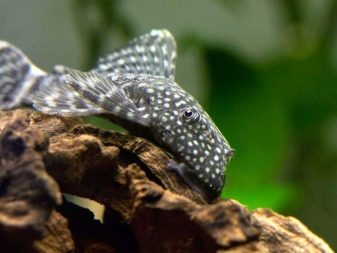
The mistake will be coexistence of discus with scalar in the same aquarium. Despite the kinship, these fish have a different idea of territoriality, they will inevitably conflict. Angelfish as a whole are quite aggressive and non-surviving, but if there is a lot of space in the aquarium, such an experiment may well be successful. Categorically not suitable for coexistence of piranha, notranha, koi, barbs, trophies.
Growing conditions
The maintenance of discus at home implies an individual launch of the aquarium, careful care, and control of the temperature of the water. It’s worth starting with the preparation and design of the interior of the tank. As soon as the decorations are prepared, the tank is filled with clean, settled water, the filter and the heater are started. Further, the aquarium should stand for some time without fish. In this case, it will be possible to track the possible presence of pathogenic microflora, the level of saturation of the medium with oxygen.
Darkened plants and algae are necessarily removed, replaced with new ones. A change in the color of the soil indicates the presence of harmful bacteria, this problem must be eliminated by increasing aeration. Once the correct mode of heating and oxygen enrichment of the water is established, new pets can be released into the aquatic environment.
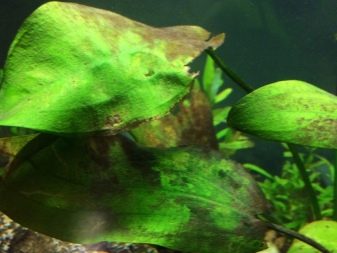

Discus has its own peculiarities regarding the choice of a comfortable temperature regime. It must be maintained in the range of +27.32 degrees Celsius with a water hardness of not more than 15 GH and acidity in the range of 6.0-6.5 pH.
Discus fish are one of the most difficult aquarium fish to care for, and it is recommended that breeders with extensive experience keep them.
The main difficulties are associated with the acclimatization of pets. For their maintenance you will need a large aquarium with a volume of 50 liters per individual. Inside you need to provide good filtration, a fairly intense flow. The use of a reverse osmosis filter helps to achieve optimal environmental parameters.
If live plants are used in the aquarium, a carbon dioxide supply system should be considered. The tank will also have to be equipped with two filters that perform mechanical cleaning. Be sure to organize aeration of water. When choosing lighting, it is important not to use too bright lamps. Lighting should not be intense, dim, diffused light will be optimal.
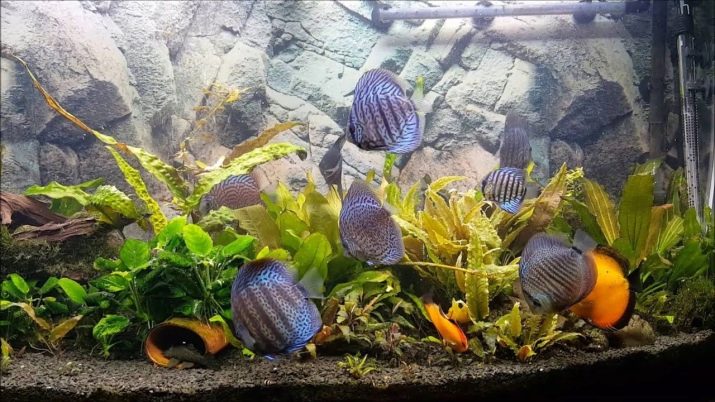
Discuses need a small number of shelters; at the bottom grottoes, snags, minerals and fragments of rock are arranged for them. Cleaning depending on the number of inhabitants is carried out 1-2 times a week. Weekly, 25-30% of the water in the aquarium is changed; before adding it, it is heated to the temperature of the environment in which the fish live.
Not the most aesthetic, but quite relevant solution for the content of discus is an aquarium without decorations and substrate. This solution provides the proper level of sanitary cleanliness, makes it possible to avoid water pollution. An aquarium without a substrate is easier to clean from fecal contamination, food debris.For a beginner breeder, such an approach can be especially convenient, as it is easier to maintain an optimal state of the environment.
Discus is a flock of fish that needs a tribe community. The optimum is considered to be the simultaneous maintenance of a flock of 6-8 fish. Shy and timid discus people need green shelters, so they feel the best. They need corners densely planted with greenery, allowing them to hide from dangers. The stability of the environment is very important for these fish - with an increase in the volume of ammonia and nitrates, pets can get sick and even die.
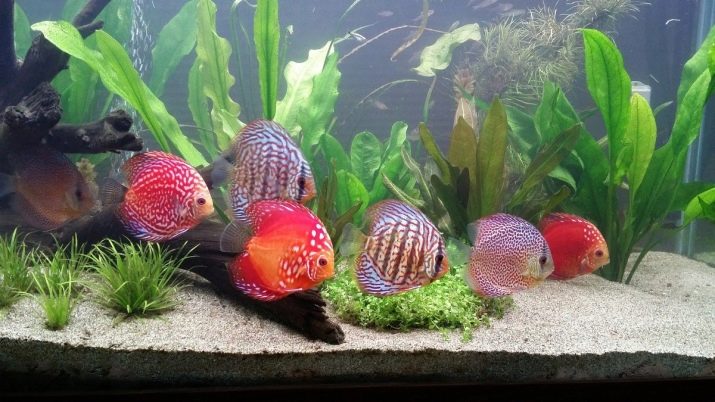
What and how to feed?
The best food for discus is animal protein. In the natural environment they are predators, eat fish fry, larvae of aquatic insects, invertebrate creatures. Small fish can also become food for hungry discus.
In an artificially created environment, feeding is also quite simple. Healthy adult fish eat with appetite:
- chopped beef heart;
- chopped shrimp;
- bloodworm;
- daphnia;
- coretra;
- tubule maker.
From vegetable crops, fish can be offered salad leaves or spinach.
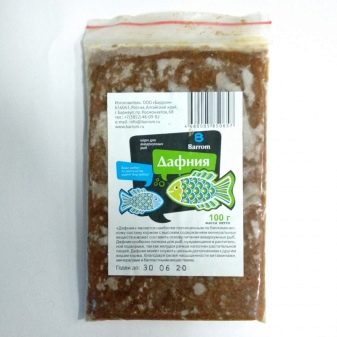
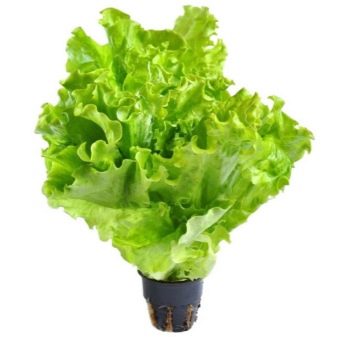
Feeding is carried out in small volumes up to three times a day, the remains of uneaten food from the aquarium are removed. The diet of fish should be quite diverse, and you should give frozen food (after preliminary thawing), and granules, and live food. This is the only way to maintain the optimum brightness of their color. With caution, worms and larvae are introduced into the food - they can be carriers of dangerous bacterial infections.
Many aquarists develop their own "mincemeat" recipes for feeding discus fish. It is based on beef heart, seafood (shrimp, mussels), fresh vegetables - carrots, cucumbers, fresh herbs are suitable. This nutritional composition is brought to a homogeneous state, given to the fish as the main dish on the menu.
Be sure to satisfy the need for discus vitamin and mineral supplements. Among the most useful of them are several vitamins.
- Vitamin A. It promotes tissue regeneration, affects the growth of the fish’s body.
- Vitamins of group B (B2, B6, B12). Their lack leads to a loss of brightness of the color, leads to obesity, interferes with the normal metabolism.
- Vitamin C. Its lack leads to a slowdown in fish growth, disrupts the proper formation of bone tissue. With a lack of vitamin C, a pathology for the development of gills can develop.
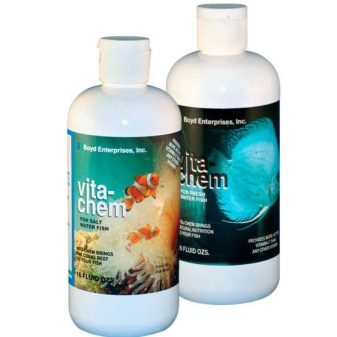
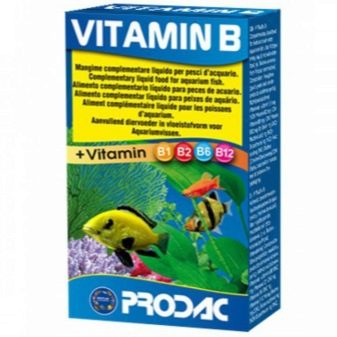
The correct and timely introduction of top dressing in the diet allows you to keep pets healthy, bright and beautiful. When feeding a diskus, it is important not to rush it - these fish eat slowly, gradually saturating, but always have a good appetite. Refusal of food is a cause for concern for the health of the inhabitants of the underwater world.
Breeding
Breeding at home in the case of discus is quite possible. These fish are remarkable for their constant consistency in choosing a partner. Couples form at a young age, persist for many years until one of the partners dies. Discus have a developed parental instinct, they take care of their offspring for a long time, take care of it until the fry become independent - this usually happens in 1.5-2 months.
In fish of this species, sexual dimorphism is slightly developed - it can be quite difficult to distinguish a male from a female.
Only during the spawning period can the main statuses of individuals in a pair be revealed. And also in males there is a wider head, an enlarged frontal part, and thickened lips. The differences can also be attributed to the geometry of the fins - the dorsal is more pointed in males, generally differs in a wide angle of inclination. With careful observation, in females you can notice the ovipositor, a wide rounded hole for throwing caviar.

Discus is characterized by a fairly late entry into puberty. Adult individuals are ready for breeding for 1.5-2 years, the ability to spawn for two to three years remains. An already formed pair is planted in a special spawning aquarium with a volume of 100 l or more. Inside the spawning grounds are the scenery: driftwood, grottoes, clay pots.
During the spawning period, it is necessary to protect the fish from any sources of stress. Even the change of water in the aquarium is done with great accuracy. Its optimum temperature is from +28 to +30 degrees Celsius. The environment in the spawning should be soft - up to 3 units, otherwise fertilization will not occur.
The couple begins to prepare for spawning in advance, in the evening. The fish are active, clean the substrate, and show the shaking of the fins. For one spawning, up to 400 eggs appear in the aquarium, then the male carries out fertilization, and the parents remain with the babies. The incubation duration for the discus is 3-4 days, a week later the fry are ready for independent swimming. During this period, 1/4 of the water is replaced daily to form optimal conditions for the growth and development of young animals.
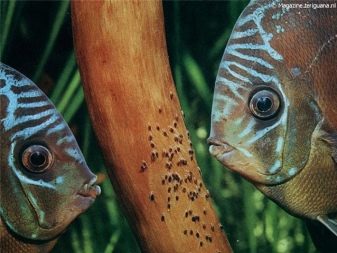
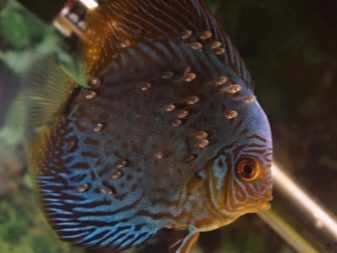
During the first days of life, the fry of the discus feed on a special secret produced on the skin of their parents. They are produced by both the father and the mother. After 14 days, you can imprison parents in the usual conditions of detention. If the secret developed on the body of the parents is not enough, you can cook the fry special food on their own based on the contents of the aquarium and dry egg powder. Thin flat pancakes are created from the thick mixture and glued to the walls of the tank.
From 5-6 days, fry can be given artemia nauplii.
Further, more independent fish are transferred to the finished feed.
Aquarium decoration
The launch and original design of an aquarium for settling discus always turns into a real design experiment. Due to the fish’s need for a rather high water temperature - from +27 to +33 degrees - there are difficulties with the selection of plants. Shading needs will also have to be taken into account - bright lighting is not suitable for residents of tropical rivers. To create a beautiful, effective design with such restrictions is quite difficult.
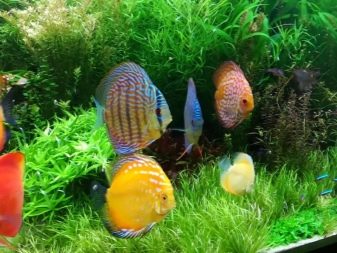
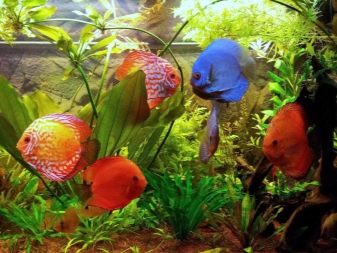
When choosing the background - soil in the aquarium, it is worth considering the coloring of the discus:
- black gravel is suitable for solid red fish like Marlboro;
- light sand, dry driftwood, algae will become a good background for white and turquoise rocks;
- golden subspecies look good against a background of saturated cobalt-colored soil.
Before picking plants, it is worth equipping an external background. The back wall of the aquarium is decorated with a black or blue screen, which allows to make the silhouettes of underwater inhabitants more clear. Since the fish are usually kept inside the view tank, problems with placement and decoration usually do not arise.
Snags in the aquarium are necessary - on average they are added 1 for every 50 liters of volume (the same amount of water is needed for each individual). They must first be carefully processed, preventing the entry of dangerous microorganisms into the aquarium. The larger the snag, the more spectacular the landscape. You can fix them on the walls or picturesquely arrange them at the bottom. The dried stems and leaves of bamboo look spectacular in an exotic aquarium; the greens from oak are also suitable, dry and clean.
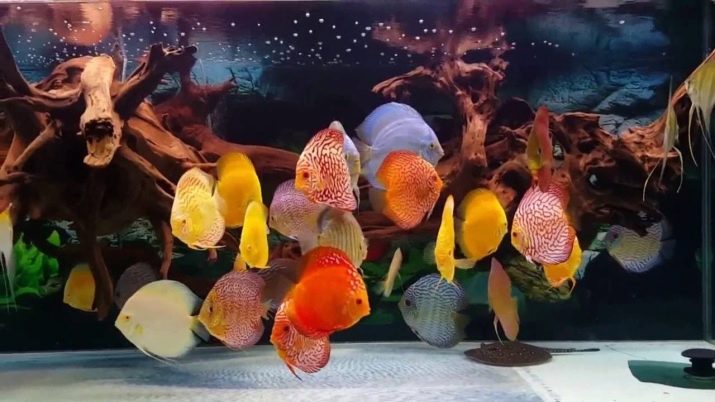
Plant selection
When breeding or keeping the discus, it is important to remember that in the natural habitat they are not spoiled by the abundance of flora. Filling the aquarium with plants to failure is not worth it - with the right selection of backgrounds and decorations, you can completely do without them. But if you want to add greenery, you should pay attention to instances with long, branched shoots that provide the necessary shadow. For planting, you need fine-grained gravel, which secures the roots in the bottom of the tank.
If such soil is categorically not suitable for discus, you can solve the problem without completely abandoning the idea of landscaping. Plants are simply planted in special pots with the desired substrate, decorated with grottoes, snags. When selecting green spaces, it is very important to make sure that they are able to exist at a constant water temperature of about +32 degrees.
Such heat-loving species include krinums, cryptocorynes, hard-leaved and curly apono-hetons.

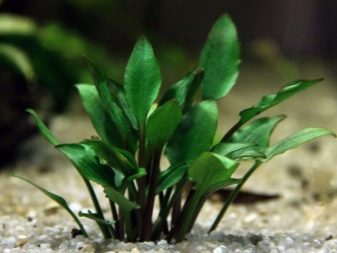
Among the popular aquarium plants that can be planted in the tank for discus, one can also note wallisneria. Its fast-growing, ordinary, gigantic, spiral-shaped varieties especially effectively decorate the back wall of the aquarium. If you want to emphasize the exotic appearance of the pet’s appearance, it’s worth adding an anubias, tiger water lilies, and Japanese blix to the aquarium.
With the right selection of plants and decorations, the discus majestically floating in the aquarium will look very attractive. Dim light in tone will help add a mysterious flicker to fish scales. But directional light can worsen microbiological indicators of water, it should be avoided when keeping exotic pets.
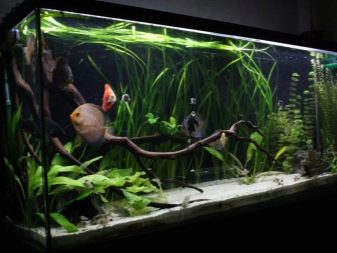
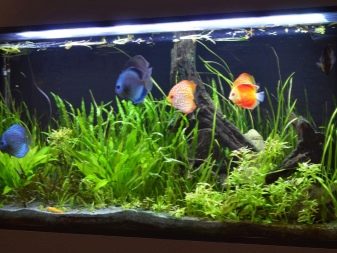
For tips on buying discs, see the next video.
